Cinema of the Future 2011
Can We? Make More Than A Cinema!
The Why Factory, TU Delft
18–24 February 2011
An initiative by ANCB The Aedes Metropolitan Laboratory in collaboration with the project Berlinale goes Kiez by the 61st International Film Festival Berlin.
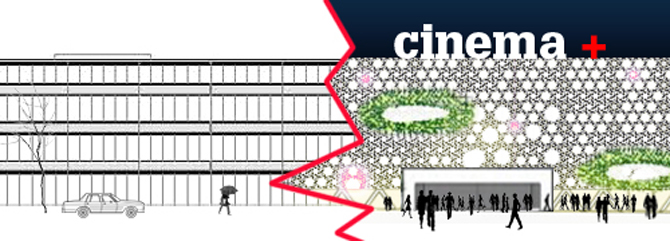
DESIGN STUDIO
Background
In 2010, on the occasion of the 60th anniversary of the Berlin International Film Festival, ANCB realised a successful international architecture Design Studio on the cinema of the future and its role in urban public space, thereby achieving a range of fascinating architectural visions and an accompanying discussion around new architectural, urban and social dimensions for the cinema typology. This year's studio is focussing on envisioning the design and functional revitalisation of the arthouse cinema typology, by facilitating its capacity to facilitate an extremely complex set of demands.
Objective
The studio will explore how the Arthouse Cinema - which was an essential component of the wide-ranging cultural offerings of the city and its districts in the 80s and 90s - can achieve a new function and integration in both urban public space and community space. The design workshop will occasion a discourse on the importance of the cinema in the neighbourhood and will prompt suggestions and develop strategies for the reactivation of this neglected cultural platform. Among other questions, it will ask whether a newly defined programme could also function in various larger dimensions, for example as a socio-cultural and economic generator for the growing creative economy, and which conceptual, architectural and urban design interventions are necessary to achieve this.
Test Site
To ground this discussion on site, and to assist the development of visionary concepts and designs, a former industrial site in the Wedding district of Berlin has been chosen as a study site. Wedding - formerly a purely industrial quarter with harbour and large market place, bordered to the north by the Mitte and Moabit districts - is experiencing a dynamic boost through the culturally diverse composition of its inhabitants and the emergence of a young creative scene. However, neither is yet reflected in the cinema culture of this district.
Studio Coordinators: Prof. Winy Maas, The Why Factory, TU Delft with Ania Molenda, Jeronimo Mejia, Luis Berriós-Negron
PROJECT BRIEFING SESSION
As a kick-off to the studio, a panel of experts from a range of associated fields - including neighbourhood management, city planning, creative industries, cinema technology developers - shared their experience, strategies and expectations for this project from their respective backgrounds. This opinion exchange built up a list of demands that a cinema of the future should respond to and created a framework for the studio.
Speakers
Johannes Kühn, Kühn Malvezzi Architects
Ivo Haulsen, Fraunhofer FIRST
Matthias Elwardt, Berlinale goes Kiez
Dr. Konrad Hummel, Nachbarschaftsheim Schöneberg e.V.
Hendrik Brauns, Neighbourhood Management Pankstraße/Wedding
Michael Künzel, Senatsverwaltung für Stadtentwicklung, Berlin
FINAL PRESENTATION
The format of an architectural competition has been chosen for the workshop. At the final presentation, the projects prepared by the participating students were judged by an expert jury according to a questionnaire developed by The Why Factory.
Guest Critics
Christophe Barlieb, cmdb architects
Christian Berg, Medienboard Berlin-Brandenburg GmbH
Lukas Feireiss, Studio Lukas Feireiss)
Francesca Fergusson, urban drift
Nina Lakeberg, Modulor Projekt GmbH
Reiner Nagel, Berlin Senate Department for Urban Development
Anh-Linh Ngo, Arch+
Florian Riegel, filmmaker
Cinema City - Integration through education in Wedding
by Ilkka Ala-Fossi, Kate Griffin, Stefan Liczkowski, Rewathi Pillai
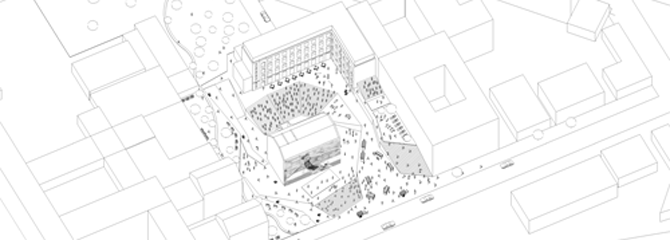
We reinterpreted the brief to include a film school. This educational approach to arthouse cinema encourages interaction between cinema and the community. The film school hosts various functions including workshops, screenings and film-making. The urban strategy consists of a bowl-shaped public space which opens to the street. This bowl is intersected by an axis that links the existing parks behind the site to the Wedding S-Bahn station. The project aimed at developing two layers: public at ground floor level and film-related functions lifted above.
An open and welcoming public space provides a new social platform for the community. This public space was created by scooping out the existing ground terrain. There are diverse spaces for multiple activities e.g. outdoor markets, film making, large public events including sports event screenings and concerts, surfaces for skaters, retail functions related to cinema, café terrace and more.
By lifting the picture house onto a pedestal and making it float, we are treating it as an icon. The open nature of the design provides views of the icon from all directions. The facades can be used for large scale movie projections. Open air screenings can be seen from the S-Bahn, creating a memorable landmark for passers-by.
by Filippo Carmignani Tirelli, Imre van der Gaag, Martijn van Mier, Kevin Walsh
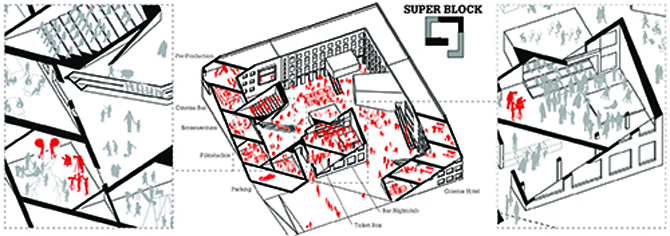
The SuperBlock is an attempt to create an autonomous machine for the consumption and production of cinema culture.
Cinema is the mirror of life, so we tried to give birth to an ‘AliveSet’ in which, on the one hand, people can directly interact and gain knowledge of movie making from the different figures involved in this process. On the other hand, people get the chance to practice film shooting inside the SuperBlock AliveSet.
In order to create an AliveSet we decided to introduce functions related to the three major aspects of city life that we recognized as being: living, working and leisure combined with social needs. We merged the given programme requirements into a mixture of neighbourhood and cinema industry related needs. In this way, we created a social platform of activities needed from the SuperBlock AliveSet and in order fulfil the three clients’ requirements.
The architectural gesture was intended to re-define the typical Berlin block whilst preserving the industrial heritage existing on site. We chose the typology of a closed urban block around a courtyard to create a space in which the community can reflect itself. Nevertheless, we chose to open the block with an inviting gesture connecting the street with the inner courtyard.
The SuperBlock wants to be a framework for entrepreneur activities and public functions in relation with the world of cinema.
by Clemens Klein, Natalia Kozyra, Anna Llonch Sentis, María José Ramos Mira
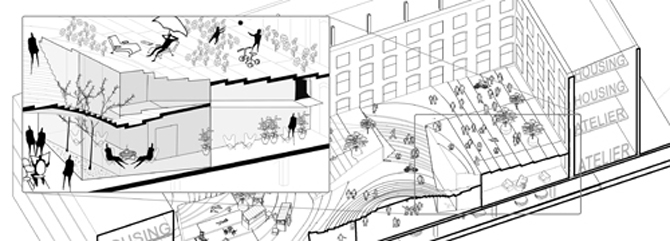
Our proposal aims at redefining the cinematic experience of an art house by embedding it into an artificial landscape in the courtyard. This creates a new green social platform for the local comunity to engage in a variety of activities.
Firstly, we connect the existing buildings to form a closed block. Then, the cinema boxes are placed into the patio according to their proximity to the surrounding programme since they will be partially used by it when the cinema is not showing a movie. Thus, the infrastructure of a cinema can also be used by the neighbouring kindergarden or disco.
Secondly, the cinemas and their enclosing buffer zones, that form autonomous entities, are connected by the landscape. It shelters the subterrainean cinema level and allows access to the surrounding housing, office and retail functions. The cinemas also channel the light to the level below, forming an attractor to guide the visitors through the space. Conversely, they become lanterns that enlighten the landscape by night.
The landscape opens to the city via a ramp, inviting passers by to explore it. On the other side of the block, a big window opens to the street revealing the activities taking place within.
Our work looks into the cinema experience which is determined by the rituals before and after the show. The „buffer zone“ between public space and cinema box addresses the different demands of viewers by generating spaces for contemplation as well as diverse circulation between the landscape and subterranean level.
by Roland Freymond, Melanie Kotz, Francis Liesting, Eva Ponsati
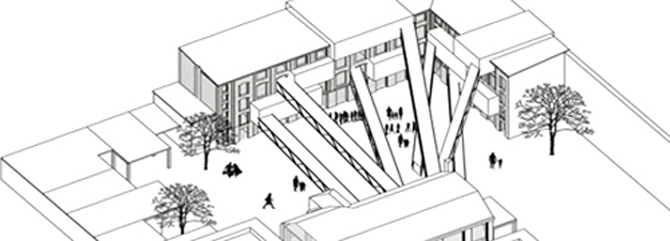
The MicaMoca complex is an industrial heritage site. In our proposal for this project, two old industrial buildings are maintained to respect the industrial atmosphere of MicaMoca. In these two buildings the most important functions are placed, the cinema/ art-house and the community centre. The outline of the inner courtyard is defined by low-rise buildings of one or two layers that contain ateliers and retail spaces. On the south side of the site, a more private sphere is created apart from the courtyard with two low-rise dwelling towers. These buildings are orientated towards the sun, with transparent facades facing south and thick, heat retaining facades facing north.
As the art-house is primarily serving the community, these functions are interconnected with bridges through the concept of a prism. This prism concept is a translation of the sun orientation of the site that reaches the community centre and projects rays of light onto the art-house. In this same manner a bridge first connects the dwelling function, which represents the community, with the community centre on the south side of the site. From this centre six bridges are connected with one cinema room each. These bridges represent a gradient; starting from the community centre they have an open, bright character that gradually dissolves into a closed, dark character when arriving at the cinema space.
The site is home to several artists that are able to display their work in the bridges that function as gallery and routing at the same time. In this way, the connection between community centre and cinema represents the local culture. The art-house function is translated to the site by seven cinema boxes that pop out of the facade of the industrial building. By night, images will be projected on these boxes, showing trailers of current movies being displayed inside the building.
by Daniel Balean, Belen Gomez Llobell, Sonsoles Guriau, Anouk Sweringa, Will Vachon
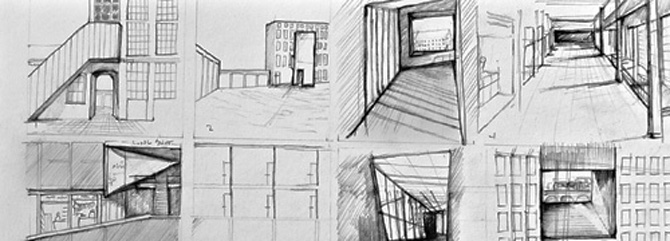
This leftover once-industrial complex is rich in spatial intricacy. The existing structures are a complex of dark recesses, bright open spaces, freight elevators, fragmented corridors. Some spaces are large and bright enough for gathering spots, some small enough for a single desk and chair or perhaps viewing screen. Rather than design a new scheme to paste onto the old, we chose to edit the spaces into a continuous linear set/sequence and to join them by a series of linking elements. Our concept is to create a cinematic linear experience through this sequence of rooms. The spaces for cinema are the climaxes; the doorways are the apertures; stairways, the intrigues. In so doing, the new Arthouse Cinema is not so much built as it is found.
Most of the existing building is kept intact. A few elements are brought in to strengthen the connections between spaces and to intensify the filmic experience of being led through them—such as an exterior grandstand, a covered bridge, a garden. Both cinema goers and inhabitants share large public rooms like the “Bazaar”—a ramped, indoor street hall which leads one past market-like stalls; Ateliers populate a bright upper loft which is accessed by a side-scrolling gangway.
The user maybe wanders through the “film strip” watching and listening only to find a great festival, people making art, children playing in kindergarten, a train crossing into view or the sun falling perfectly between two walls.
by Elena Caballero, Marcela Kozlik, Garyfalia Pitsaki, Jonathan Telkamp
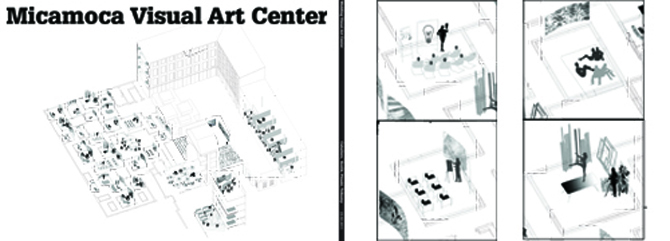
Our proposal is about redefining the concept of the cinema into a Visual Art Centre by combining different visual arts into a maze. Visitors are surprised to find unexpected routes and to get in touch with several visual arts, not only movies but also photography, theatre, ballet and music in small rooms. By providing several flexible working and exhibition spaces, this art centre becomes part of Berlin's contemporary art scene. Our vision of the cinema of the future is people being able to socialise in small groups, instead of the impersonal atmosphere of larger cinema complexes. This is a way to recreate the concept of a conventional cinema. Intimacy vs. anonymity. The multiple choices given in the corridors are an active way to experience the public space, there is no predetermined route, and visitors have to be part of the diversity and complexity of the space and the trajectory of the unexpected. The result is an experience of getting lost in a labyrinth full of duality, sampling, uniformity in texture and the quantity of points where decisions need to be made.

